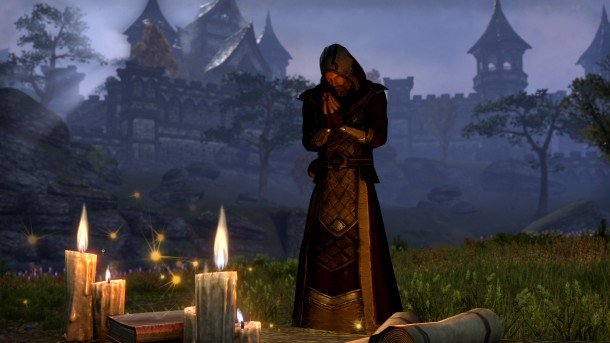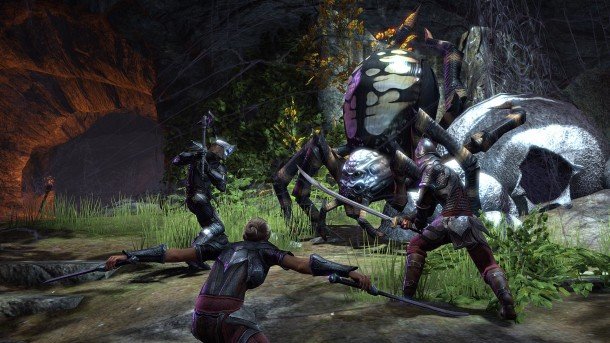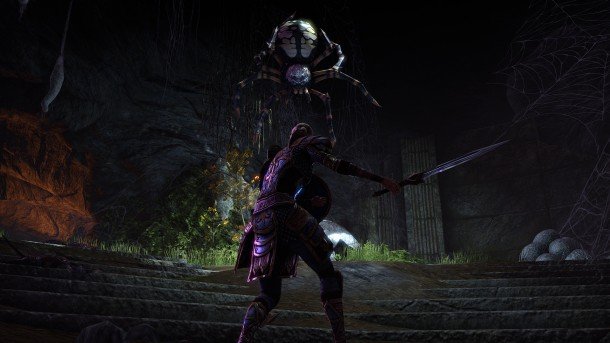
If I had to pick a handful of gaming moments that will stay with me forever, three of them would be stepping into Morrowind, Oblivion, and Skyrim for the first time. Another would be my first few days in World of Warcraft. At face value, combining Elder Scrolls with an MMO should lead to instant RPG nirvana. But the reality of the situation is much different.
Elder Scrolls Online is being created in an era of acute MMO fatigue. An era in which gamers who put off term papers to work the slot machine of mostly-samey content direction look to any new entry in the genre with the suspicion and cynicism of a too-many-times-spurned romantic. (Not that I would know anything about that.)
It was with this in mind that I went hands-on with ZeniMax Online's new contender to ask the question: Is this just another MMO with an Elder Scrolls veneer? Or has the dream of a living, multiplayer Elder Scrolls world been realized?
If you're looking for a comprehensive rundown of the game's headline features, meanwhile, Chris has discussed them all in some detail in his Elder Scrolls Online hands-on preview - including the newly announced first-person mode, stealth, skills and more. You should also check out our video interview with game director Matt Firor and lead gameplay designer Nick Konkle about their experiences crafting the game.
What I loved
- Elder Scrolls-style combat. ESO has been designed around a lot of the same basic ideas we're familiar with from Skyrim and Oblivion. Left mouse to attack, right mouse to block. Holding block and attacking executes a bash that can interrupt spellcasting. Arrows and spells have to be aimed with your reticle. You do have a hotbar, but it's pared down to about Guild Wars 2-size , and the devs have clearly stated that they don't want you worrying about it too much in combat. You also won't be forced into Tank/Healer/DPS roles. Adhering to said roles will help players manage the game's hardest enemies, according to the devs. However, they're looking to maximize the variety of builds that are viable against such challenges.
This isn't to say that it feels exactly like Skyrim or Oblivion... but we'll get into that on the next page.

- You can build your character however you want, and skills level up as you use them. You do get a token choice of "classes" (which are kind of boring and unnecessary, and will be discussed on the next page), but it's a choice that can be completely ignored if you choose. Your class determines three of the Skill Lines you have access to, while the others, universal across all characters, are based on weapon types, fighting styles, armor classes, and magic schools.
You have to have a certain overall character level to unlock new skills (think perks from Skyrim, or talents from other MMOs), but once unlocked, they will progress in power through repeated usage. It's not precisely the same as the way it works in Skyrim, but if you, say, hit level 5 and unlock a two-handed cleave, that cleave skill on your hotbar will get stronger the more you use it.
- The music and art style feel like Elder Scrolls. Some of the early previews we saw seemed to feature slightly goofy, overly-cartoony character models. That was not the case in the build I played (though it could be an issue of starter armor looking more Spartan and realistic). The models seemed proportioned correctly, and the textures, characters, and architecture struck just the right balance between fantasy and gritty realism we've seen in the series' history.
The environments still suffer from "MMO gigantism," which I'm told has something to do with camera distances, though I've never really bought its necessity. Luckily, from what I saw, it's not as horrendously distracting as it was in The Old Republic.
- Full voice acting, and quest choices that matter. Every quest in the game will feature voice acting, and from what was shown, it mostly rates somewhere between okay and good. You'll also get to make choices in quests that affect more than an alignment meter, with recurring characters sometimes living or dying based on what you do. And unlike TOR, some of them will actually show up again if you spared their lives. We didn't get to play enough to see how far this extends, but it already seems to be more impactful than the "Take your Light/Dark Side points and never speak of this again" model that TOR used.

- A promising crafting system. I could count the MMOs that have done this well on one hand, following an unfortunate table saw accident. ESO's crafting is actually one of the more potentially fun systems I've had a look at in a while. In addition to base ingredients, you'll be able to introduce additives to your creations, each of which have four random properties (like Skyrim's alchemy ingredients). It encourages experimentation in a way I found entertaining.
Oh, and every armor piece and weapon that was shown in the demo can be made in one of nine racial styles, tied to the playable races of Tamriel. All crafters start off able to craft their own racial style, but can learn others.
- Enemies that work together intelligently. The most unexpected thing that impressed me about ESO was the design of the enemy AI. As they move about in combat, enemies will adjust their tactics based on how many allies they have nearby, the position of those allies, and what their allies are capable of. Humanoids will call to each other, allowing you to react to their intentions. Synergies are created when rogue-types douse the ground in oil, so their mage friend can light it aflame under your feet. In a particularly extreme example, a group of necromancers sacrificed one of their own in a ritual to summon a powerful, undead bruiser.
They can't pull off the kinds of complex maneuvers a player party might, but compared to common world enemies in other MMOs, they're a few tactical steps ahead.
On the next page: What I didn't love.
The biggest gaming news, reviews and hardware deals
Keep up to date with the most important stories and the best deals, as picked by the PC Gamer team.
Len Hafer is a freelancer and lifelong PC gamer with a specialty in strategy, RPGs, horror, and survival games. A chance encounter with Warcraft 2: Tides of Darkness changed her life forever. Today, her favorites include the grand strategy games from Paradox Interactive like Crusader Kings and Europa Universalis, and thought-provoking, story-rich RPGs like Persona 5 and Disco Elysium. She also loves history, hiking in the mountains of Colorado, and heavy metal music.

